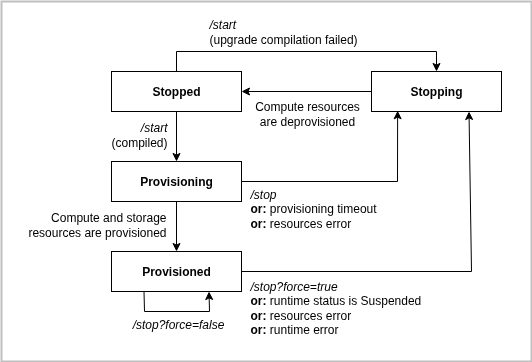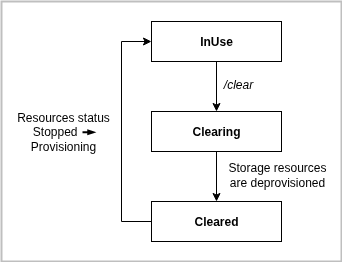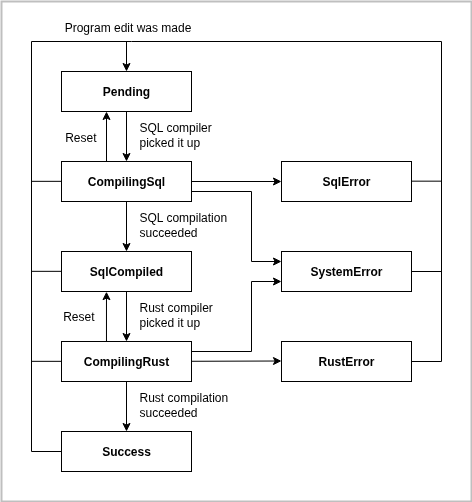Reference: Pipeline lifecycle
A pipeline's lifecycle goes through several states as the control plane allocates compute and storage resources for it. This page is a reference guide that explains the underlying state machines, aimed at Feldera contributors and advanced users.
The status of a pipeline, returned by the status endpoint consists of four related yet separate statuses:
- Resources status: whether compute and storage resources are provisioned to run the pipeline.
- Storage status: whether storage resources are in use or are (being) cleared.
- Runtime status: status reported by the pipeline process itself regarding its current activity.
- Program status: whether the SQL (with UDF) is being or has been compiled to an executable.
For convenience, there is additionally a combined status that combines the resources status with the runtime status as they are complementary.
Resources status
There are two categories of resources: storage and compute resources. The backing that provides these resources depends on the Feldera edition:
-
OSS edition:
- Storage resources: a local directory
- Compute resources: a local process
-
Enterprise edition:
- Storage resources: Kubernetes PersistentVolumeClaim (PVC)
- Compute resources: Kubernetes StatefulSet, Service and ConfigMap
- The StatefulSet pod keeps the pipeline process continuously alive.
- Provisioning means the creation of the Kubernetes objects and passing the first health check, conversely deprovisioning means the deletion of the Kubernetes objects.
Resources status API
The resources status reflects whether storage is (being) provisioned and whether compute is (being) provisioned or deprovisioned.
You control this through the /start and /stop endpoints:
/startsets the desired status toProvisioned/stopsets the desired status toStopped
These calls return right away, but the actual provisioning or deprovisioning happens asynchronously
and may take time. Storage can only be deprovisioned when the resources status is Stopped, and its
state is tracked by the storage status.
Relevant API fields:
deployment_id(set becomingProvisioning, unset becomingStopping)deployment_config(set becomingProvisioning, unset becomingStopping)deployment_error(set becomingStopping(if error), unset becomingProvisioning)deployment_initial(set when desired status becomesProvisioned, unset becomingStoppingor desired status becomesStoppedwhile status is stillStopped)deployment_resources_statusdeployment_resources_status_sincedeployment_resources_desired_statusdeployment_resources_desired_status_since
Resources status table
| Resources status | Compute resources | Storage resources | Storage status | Program status | Runtime status |
|---|---|---|---|---|---|
| Stopped* | Deprovisioned. | Any | Any | Any | - |
| Provisioning | Being provisioned. | Already provisioned or being provisioned. | InUse | Success | - |
| Provisioned* | Provisioned. | Provisioned. | InUse | Success | Any |
| Stopping | Being deprovisioned. | Provisioned. | InUse | Success | - |
| (*) Also a possible desired status |
Resources status diagram

Resource status diagram notes:
- Compilation requirement: A pipeline must be compiled (program status
Success) before it can move fromStopped→Provisioning. If/startis called before compilation ("early start"), it waits until compilation succeeds (then goes toProvisioning) or fails (then goes toStopping). - Provisioning timeout: Provisioning has a max time limit (e.g., waiting for Kubernetes objects to
become healthy). If it times out, the pipeline automatically stops.
- Example: Pods in a StatefulSet take too long to schedule.
- Example: PersistentVolumeClaim (PVC) allocation took too long.
- Resources error: A fatal, unrecoverable issue with compute or storage. Temporary unavailability
(like pod rescheduling) doesn’t count.
- Example: StorageClass can’t allocate a PVC due to lack of space.
- Example: StatefulSet deleted.
- Example: Process terminated (OSS).
- Runtime error: The pipeline itself fails irrecoverably.
- Example: Pipeline circuit panicked
- Stopping due to error: If provisioning timeout, resources error or runtime error occurs, it will transition to Stopping with the corresponding error set.
- Initial runtime desired status for /start: Use
/start?initial=standby|paused|running(default:running) to control the initial state. Once set toPausedorRunning(also at runtime), you can’t return toStandby. - Graceful stop: Use
/stop?force=false(default) to request the pipeline to stop cleanly: shut down the circuit and checkpoint before compute is deprovisioned. Only applies when resources areProvisioned; theforceparameter is ignored otherwise.
Storage status
Storage is created when the pipeline enters Provisioning, but is not removed during Stopping.
This lets you stop and restart a pipeline while keeping existing storage.
When the pipeline is Stopped, you can explicitly choose to deprovision (“clear”) the storage.
What “clearing” does depends on the edition.
- OSS edition: removing the local directory.
- Enterprise edition: deleting the Kubernetes PersistentVolumeClaim.
Storage status API
The storage status shows whether storage is provisioned, being cleared, or already cleared.
Deprovisioning is triggered with the /clear endpoint, but only when resources are Stopped.
While clearing, the pipeline cannot be started.
There is no "desired" storage status. Calling /clear sets the status to Clearing and
returns immediately. The actual cleanup runs asynchronously, and once finished the status
becomes Cleared.
Relevant API fields:
storage_status
Storage status table
| Storage status | Storage resources |
|---|---|
| Cleared | Deprovisioned |
| Clearing | Being deprovisioned. |
| InUse | Likely provisioned. It is possible it is not provisioned if the pipeline is stopped at the early beginning of Provisioning. |
Storage status diagram

Runtime status
The runtime status only exists when resources are Provisioned, since it reflects the state of the running pipeline
process. Unlike other statuses, it isn’t controlled by the runner but reported by the pipeline process itself.
Runtime status API
The runner polls the pipeline to track both runtime status and desired status.
- At startup,
/start?initial=standby|running|pausedsets the initial desired status. - During runtime, you can change it with
/activate,/resume,/pause, or/stop?force=false.
These endpoints only work when resources are Provisioned and the runtime status is not Unavailable.
The one exception to this is /stop?force=false, which will result in a forceful stop if resources is not
Provisioned.
Relevant API fields:
deployment_runtime_statusdeployment_runtime_status_sincedeployment_runtime_desired_statusdeployment_runtime_desired_status_since
Runtime status table
| Runtime status | Description |
|---|---|
| Unavailable | Unable to determine the current runtime status. This status is never returned by the pipeline endpoint itself, but only determined by the runner. This can occur notably in two scenarios: (1) the runner is unable to (in time) receive a response for its sent request to the pipeline status endpoint, or (2) it received back a 503 Service Unavailable. |
| Standby* | The pipeline constantly pulling the latest checkpoint to S3 but not processing any inputs. |
| AwaitingApproval* | The pipeline has been modified and is currently awaiting the user's approval to proceed with bootstrapping modified views. See Modifying a Pipeline for details. |
| Initializing | The input and output connectors are establishing connections to their data sources and sinks respectively. |
| Bootstrapping | The pipeline was modified since the last time it was started, and is currently computing modified views. See Modifying a Pipeline for details. |
| Replaying | Input records that were stored in the journal but were not yet processed, are being processed first. |
| Paused* | The input connectors are paused. |
| Running* | The input connectors are running. |
| Suspended* | The circuit is terminated and a final checkpoint has been made. This status is normally not observed as the resources (desired) status will become Stopped once it is detected. |
| (*) Also a possible desired status |
Runtime status diagram
There are several transition restrictions:
- Standby only once: A pipeline can only have (desired) status
Standbyonce (or unless the storage is cleared). Once the pipeline has been set to becomePausedorRunning, it is not allowed to again set desired status toStandby. - Suspended can only be cleared by stop-and-start: Once a pipeline has been suspended, it can only again become
PausedorRunningagain by stopping (which will happen automatically) and starting the pipeline.
The diagram will be added in the future.
Program status (compilation status)
The program status only varies during the pipeline Stopped resources status, as the pipeline
can only be edited in that status, and it must have successfully compiled before being started.
Program status API
Whenever the fields relevant to the pipeline program are edited, the program will be automatically recompiled.
Relevant API fields:
program_statusprogram_status_sinceprogram_codeprogram_configudf_rustudf_tomlprogram_info(set when becomingSqlCompiled, unset when becomingPending)program_error(set when becomingSystemError,SqlErrororRustError, unset when becomingPending)program_version
Program status table
| Program status | Description |
|---|---|
| Pending | Pipeline program is not compiled, and is awaiting being picked up for SQL compilation. |
| CompilingSql | A compiler is compiling the pipeline program SQL. |
| SqlCompiled | The SQL has been compiled to Rust code. The pipeline program is awaiting being picked up for Rust compilation. |
| CompilingRust | A compiler is compiling the pipeline program Rust code (both generated and from UDFs). |
| Success | The pipeline program is successfully compiled and can be run. |
| SystemError | A system error (e.g., out of disk space) occurred, causing either SQL or Rust compilation to fail. |
| SqlError | An error in the SQL caused its compilation to fail. |
| RustError | An error in the generated or UDF Rust code caused its compilation to fail. |
Program status diagram

Program status diagram notes:
- Resets: If the SQL or Rust compiler goes down during compilation, upon restart it will reset the compilation status before picking up a new job.
- Rust caching: Rust compilation makes use of multiple crates to enable faster compilation through parallelism and caching of already prior compiled crates.
Combined status
Because runtime status is not only set if the resources status is Provisioned, the API for
convenience has a combination status which combines resources status and runtime status
Combined status API
Relevant API fields:
deployment_statusdeployment_status_sincedeployment_desired_statusdeployment_desired_status_since
Combined status table
- The combined statuses are all resources statuses except
Provisionedjoint with the runtime statuses. - The combined desired status are all resources desired status except
Provisionedjoint with the runtime desired statuses.
Combined status diagram
The diagram is the resources status diagram with the box for Provisioned replaced with the diagram of
runtime status.